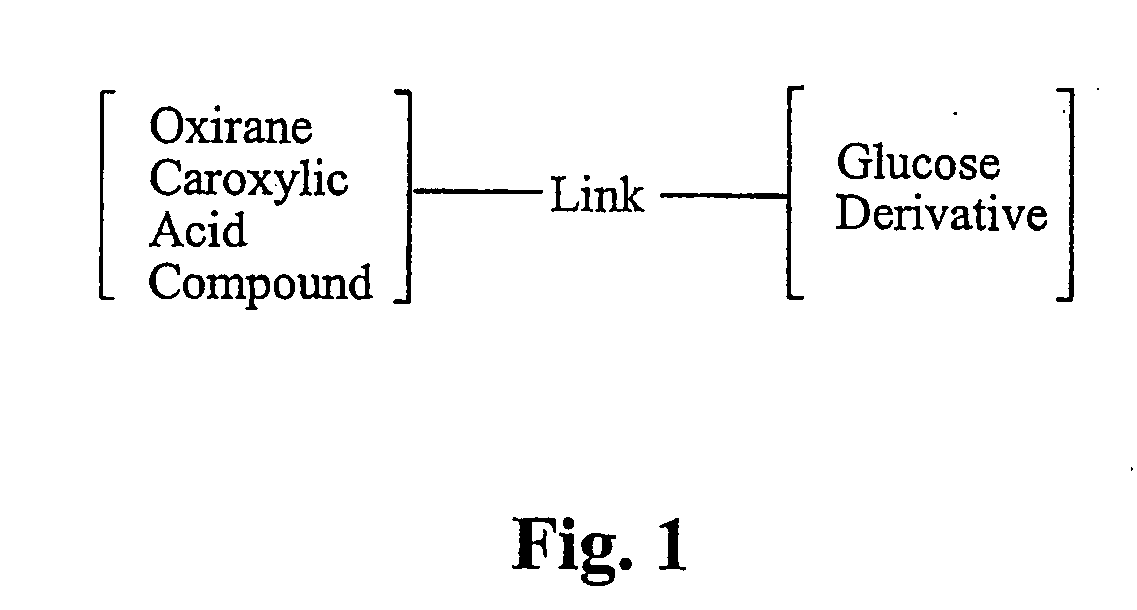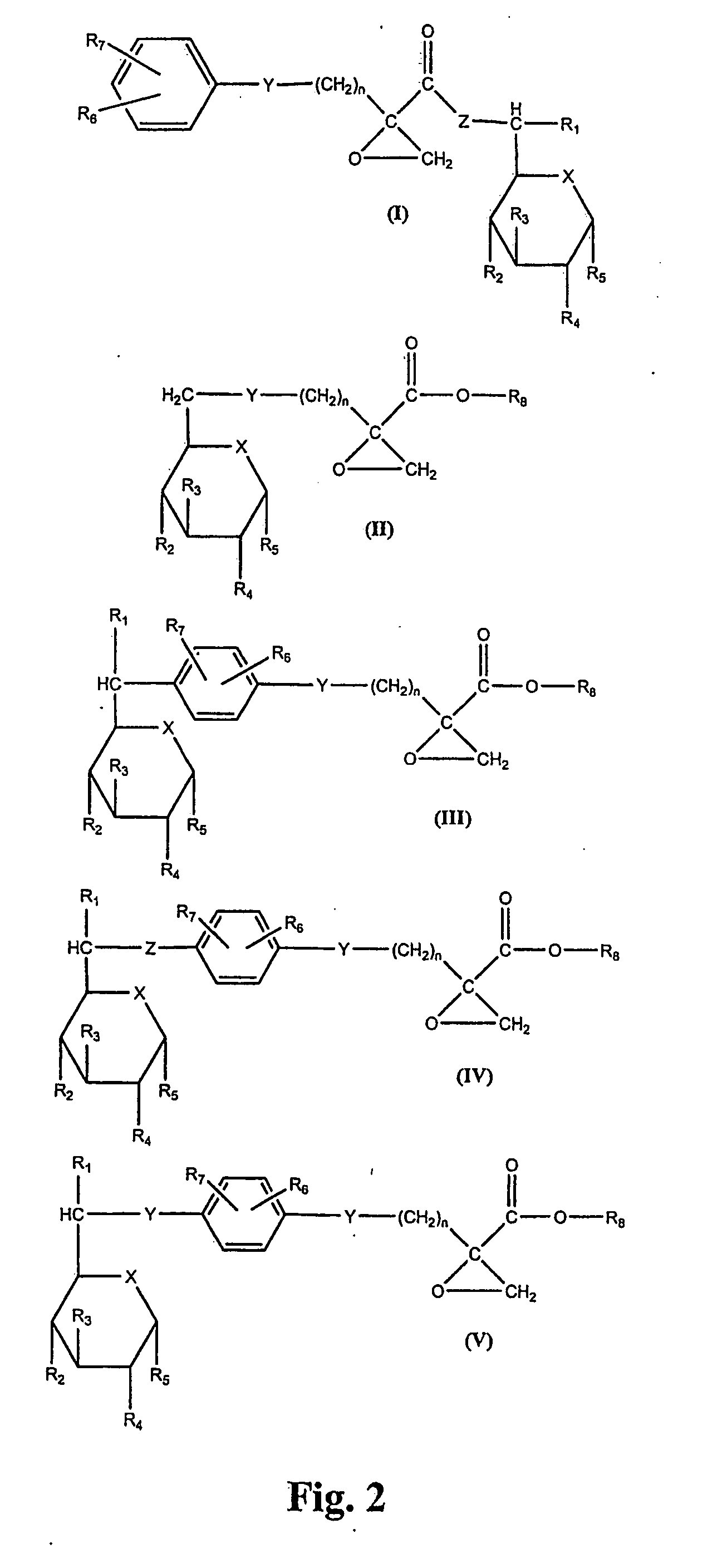Therapeutic Bifunctional Compounds
a technology of bifunctional compounds and therapeutic agents, applied in the direction of biocide, cardiovascular disorder, drug compositions, etc., can solve the problems of cancer death, cancer cell death, and multi-drug resistant tumor cells, and achieve the effect of enhancing wound healing
- Summary
- Abstract
- Description
- Claims
- Application Information
AI Technical Summary
Benefits of technology
Problems solved by technology
Method used
Image
Examples
example 1
[0039]One can use in the invention, to treat MDR tumors, the bifunctional compound (I) of FIG. 2, having the structure:
where R1 represents a hydroxyl group, a halogen atom, a thiol group, or CO—R9 where R9 represents an alkyl group of from 1 to 20 carbon atoms, R4 represents a hydrogen atom or a halogen atom, R2, R3 and R5 each represent a hydroxyl group, a halogen atom, or CO—R9 and where at least two of R2, R3 and R5 are hydroxyl groups, R6 and R7 each represent a hydrogen atom, a halogen atom, a 1-4 carbon atom alkyl group, a 1-4 carbon atom alkoxy group, a nitro group or a trifluoromethyl group, R8 represents a hydrogen atom or a 1-4 carbon atom alkyl group, X represents O or S, Y represents (CH2)k where k is from 2 to 8, or the grouping —O—(CH2)m—, m is 0 or a whole number from 1 to 4, n is a whole number from 2 to 8 wherein the sum of m and n is a whole number from 2 to 8, and Z represents O, S or the grouping (CH2)p—O—(CH2)q or (CH2)p—S—(CH2)q, and p and q are each 0 or a who...
example 2
[0041]One can use in the invention, to treat MDR tumors, the bifunctional compound (II) of FIG. 2, having the structure:
where R4 represents a hydrogen atom or a halogen atom, R2, R3 and R5 each represent a hydroxyl group, a halogen atom, or CO—R9 where R9 represents an alkyl group of from 1 to 20 carbon atoms, and where at least two of R2, R3 and R5 are hydroxyl groups, R8 represents a hydrogen atom or a 1-4 carbon atom alkyl group, X represents O or S, and Y represents (CH2)k where k is from 2 to 8, or the grouping —O—(CH2)m—, m is 0 or a whole number from 1 to 4, n is a whole number from 2 to 8 wherein the sum of m and n is a whole number from 2 to 8.
[0042]A preferred specific bifunctional compound (II) is shown in FIG. 3 as compound (VII), having the structure:
example 3
[0043]One can use in the invention, to treat MDR tumors, the bifunctional compound (III) of FIG. 2, having the structure:
where R1 represents a hydroxyl group, a halogen atom, a thiol group, or CO—R9 where R9 represents an alkyl group of from 1 to 20 carbon atoms, R4 represents a hydrogen atom or a halogen atom, R2, R3 and R5 each represent a hydroxyl group, a halogen atom, or CO—R9 and where at least two of R2, R3 and R5 are hydroxyl groups, R6 and R7 each represent a hydrogen atom, a halogen atom, a 1-4 carbon atom alkyl group, a 1-4 carbon atom alkoxy group, a nitro group or a trifluoromethyl group, R8 represents a hydrogen atom or a 1-4 carbon atom alkyl group, X represents O or S, and Y represents (CH2)k where k is from 2 to 8, or the grouping —O—(CH2)m—, m is 0 or a whole number from 1 to 4, n is a whole number from 2 to 8 wherein the sum of m and n is a whole number from 2 to 8.
[0044]A preferred specific bifunctional compound (III) is shown in FIG. 3 as compound (VIII), having...
PUM
| Property | Measurement | Unit |
|---|---|---|
| body weight | aaaaa | aaaaa |
| body weight | aaaaa | aaaaa |
| size | aaaaa | aaaaa |
Abstract
Description
Claims
Application Information
 Login to View More
Login to View More - R&D
- Intellectual Property
- Life Sciences
- Materials
- Tech Scout
- Unparalleled Data Quality
- Higher Quality Content
- 60% Fewer Hallucinations
Browse by: Latest US Patents, China's latest patents, Technical Efficacy Thesaurus, Application Domain, Technology Topic, Popular Technical Reports.
© 2025 PatSnap. All rights reserved.Legal|Privacy policy|Modern Slavery Act Transparency Statement|Sitemap|About US| Contact US: help@patsnap.com



